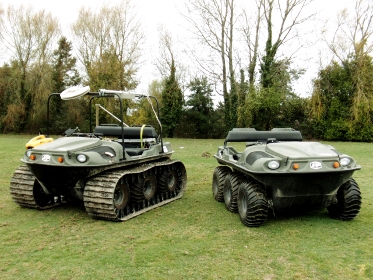Project: Argo
Technical details:
Based on a Argo Frontier 580, `the Argo' is a 6-wheel drive amphibious petrol-powered skid-steer robotic system with an 18bhp engine. The custom built on-board control system consists of a PIC18F4550 micro-controller for low level control of steering (via a LA12 liner-actuator) and throttle (via a high-torque servo) and a GUMSTIX embedded Linux computer for network communications and low-level safety control. Equipped with a SICK LMS111 laser range finder, 9-DOF Inertial Measurement Unit, HMC6343 tilt-compensated compass, ADXL 330 3-axis accelerometer, wheel odometry sensors and a 10Hz GPS, the Argo has a variety of sensors useful for pose estimation, obstacle avoidance and navigation.
The Argo also features a number of scientific instruments, including a terrestrial laser scanner and a penetrometer. The Argo is capable of towing additional scanning equipment such as ground penetrating radar arrays.
Research / Projects:
The Argo is currently being used for research into robotic survivability and scientific goal achievement techniques and, as a real-world demonstration, The Argo is to be shipped to Greenland in March 2011 for the autonomous scanning of glaciers and the Greenland ice-sheet in an attempt to understand better the effects of global warming and climate change on ice sheet movements. During this project Argo is also going to be used as a base station for a visual navigation platform.
Recently the Argo was used without autonomy in New Zealand as a part of the Rees Scan (http://www.reesscan.org/) research project, collecting terrestrial laser scanner data for the hyper-scale modelling of the Rees River before and after flood events.
Related publications:
- Clarke, M. (2010) Development of a Control System and Simulator for a Skid-Steer Amphibious Vehicle, MEng. Department of Computer Science, Aberystwyth University. (http://hdl.handle.net/2160/5297)
- Clarke, M. and Blanchard, T. “Development of a Control System for a Skid-Steer Amphibious Vehicle”, in proceedings of TAROS 2010, Plymouth, UK, Pages 41 – 46, Sept 2nd 2010 (http://cadair.aber.ac.uk/dspace/handle/2160/5312)
